15 Most Sustainable Loungewear Brands: The Conscious Consumer’s Guide
Affiliate Disclosure
Hey fellow impactful ninja ?
You may have noticed that Impactful Ninja is all about providing helpful information to make a positive impact on the world and society. And that we love to link back to where we found all the information for each of our posts.
Most of these links are informational-based for you to check out their primary sources with one click.
But some of these links are so-called "affiliate links" to products that we recommend.
Why do we add these product links?
First and foremost, because we believe that they add value to you. For example, when we wrote a post about the environmental impact of long showers, we came across an EPA recommendation to use WaterSense showerheads. So we linked to where you can find them. Or, for many of our posts, we also link to our favorite books on that topic so that you can get a much more holistic overview than one single blog post could provide.
And when there is an affiliate program for these products, we sign up for it. For example, as Amazon Associates, we earn from qualifying purchases.
What do these affiliate links mean for you?
First, and most importantly, we still only recommend products that we believe add value for you.
When you buy something through one of our affiliate links, we may earn a small commission - but at no additional costs to you.
And when you buy something through a link that is not an affiliate link, we won’t receive any commission but we’ll still be happy to have helped you.
What do these affiliate links mean for us?
When we find products that we believe add value to you and the seller has an affiliate program, we sign up for it.
When you buy something through one of our affiliate links, we may earn a small commission (at no extra costs to you).
And at this point in time, all money is reinvested in sharing the most helpful content with you. This includes all operating costs for running this site and the content creation itself.
What does this mean for me personally?
You may have noticed by the way Impactful Ninja is operated that money is not the driving factor behind it. It is a passion project of mine and I love to share helpful information with you to make a positive impact on the world and society. However, it's a project in that I invest a lot of time and also quite some money.
Eventually, my dream is to one day turn this passion project into my full-time job and provide even more helpful information. But that's still a long time to go.
Stay impactful,
Amid growing concerns about the textile industry’s environmental impact, there is pressure to find greener clothes for your wardrobe, from outerwear to loungewear. Unfortunately, fashion greenwashing makes it harder for you and all other consumers to figure out which clothing brands offer the most eco-friendly garments. So, we had to ask: Which are the most sustainable loungewear brands?
The most sustainable loungewear brands include hernest project, Subset, and Underprotection, which use low-impact natural materials, reduce carbon emissions, and strive for textile circularity. In addition, The Ethical Silk Company and Boody commit to waste reduction and ethical manufacturing.
Whether you are searching for a sweatshirt or a set of pajamas to add to your wardrobe without negatively impacting the soil, the water, the animals, and other people, there is a brand for you. So, let’s keep reading to learn more about the most sustainable loungewear brands and how they ensure sustainable, ethical practices.
Here’s How We Selected the Most Sustainable Loungewear Brands
The sustainability of loungewear depends mostly on the fabric used, whether it is synthetic or natural, plant-based or animal-derived.
“Sustainable: The ability to be maintained at a certain rate or level | Avoidance of the depletion of natural resources in order to maintain an ecological balance”
Oxford Dictionary
The brands on this list were chosen based on their commitment and actions to promote sustainable practices while reducing the environmental impacts of the textile industry.
They are transparent about their materials, processes, and workforce management within their supply chain.
Some brands focus their efforts on reducing waste and optimizing natural resources while others strive to reduce the carbon footprint of their clothes.
All of these brands share the commitment to reshape the textile industry toward a more sustainable and Earth-friendly sector.
These Are the 15 Most Sustainable Loungewear Brands
Most Sustainable Loungewear Brands
Overall, these loungewear brands are sustainable. Yet, they take various approaches to reduce environmental impacts and uphold ethical standards. Let’s dive into each brand and find out more.
hernest project: Sustainably Made Sleepwear and Loungewear

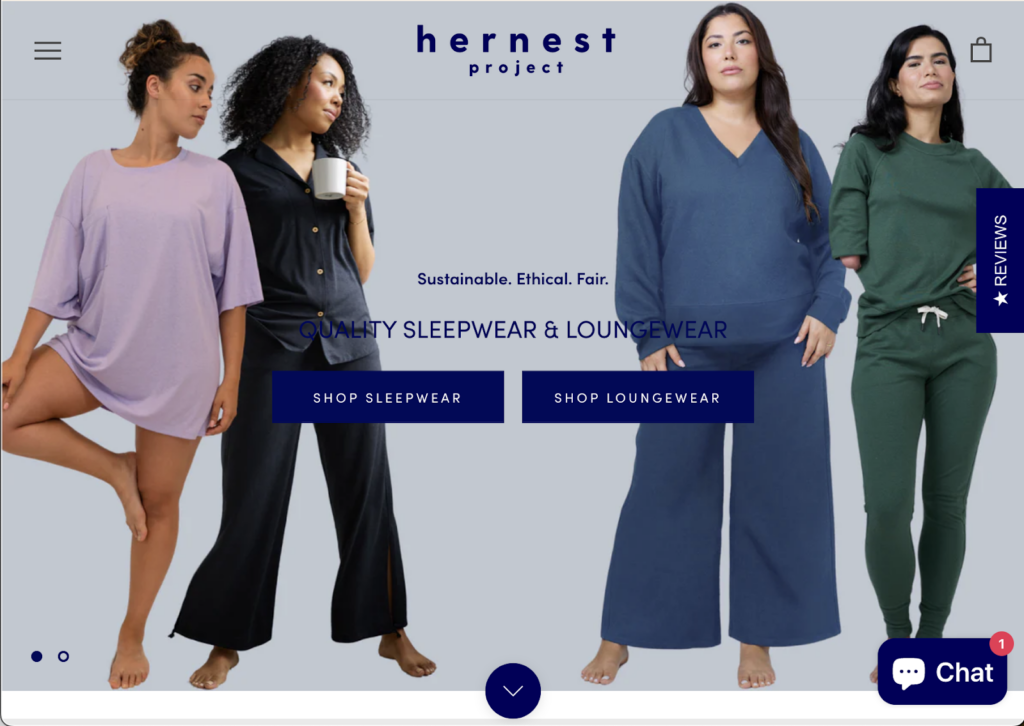
“We cause zero harm. This means that we do not contribute to the systemic increase in substances extracted from the earth’s crust, to the accumulation of compounds that do not break down in nature, to degradation of natural systems and to the barriers that prevent people from meeting their needs.”
hernest project
🌎
How do they ensure their sustainability?
hernest project ensures sustainability by sourcing a high proportion of low-impact materials, reducing textile waste, and offsetting carbon emissions to reach carbon neutrality. Firstly, all their fabrics bear OEKO-TEX® STANDARD 100 certification and feature Bluesign®-approved dyes. Low-impact plant-derived and plant-based TENCELTM, recycled cotton, and organic cotton account for the highest proportions of their collection (37%, 21%, and 21%, respectively). Additionally, they lessen the burden on earth resources by using recycled fabrics, including recycled lyocell, recycled linen, and recycled spandex. Regarding packaging, hernest project uses compostable garment protectors, brief liners, eCom mailers, and organic cotton brand tags. Secondly, they cut down textile waste by operating on limited runs, employing cutting-edge and computer-aided programs to minimize offcuts in the production process, and having their production supplier recycle all offcuts. Excess fabric is made into scrunchies. Additionally, hernest project designs are based on slow-fashion principles of timelessness and versatility. They strive toward circularity by partnering with Treet to facilitate the sale of pre-loved garments. Last but not least, they invest in offset projects such as renewable energy, forest conservation, and energy efficiency to ensure that every item ordered and sold on their site is carbon neutral.
🌐
How do they ensure their ethics?
hernest project ensures their ethics by binding their supplier with a Code of Conduct, covering all of the ILO’s Fundamental Principles and Rights at Work. They also have traceability for their Tier 1 and Tier 2 suppliers.
🤝
Are they part of any giving-back programs?
hernest project works with women’s shelters to donate returns and samples of clothes.
🛍️
What is their product range?
- Best for: womenswear
- Product range: tops, cardigans, crewnecks, joggers, pants, shorts, tanks, T-shirts, sleepwear, loungewear, plus-size
- Price range: $$
- Size range: XXS–3XL
Subset: Carbon-Neutral Organic Cotton Underwear


“By seeking out the most environmentally responsible processes, low-impact fabrics and ethical manufacturing, we swap the greenwashing for integrity and accountability. ”
Subset
🌎
How do they ensure their sustainability?
Subset prioritizes sustainability by sourcing a high percentage of low-impact fabrics, offsetting carbon emissions, and facilitating underwear recycling. Firstly, they use GOTS-certified organic cotton, TENCEL™, recycled polyester, and regenerated and recycled nylon to reduce environmental impacts. For example, the Tank Bralette contains certified organic cotton (95% of the fabric), recycled nylon (83% of the straps), and TENCEL™ (69% of the band). Organic cotton, in particular, accounted for 92,1% of their fiber portfolio for 2022. Secondly, they reduce the impact of their carbon emissions with offsetting projects verified by Climate Neutral. For example, in 2022, they supported clean energy projects in India and Kenya. More importantly, they find ways to reduce their carbon footprint, such as using solar-powered energy in their supply chain and localized sourcing. Thirdly, in 2018, Subset launched the world’s first recycling program to save underwear, socks, bras, and tights from ending up in landfills. In 2022, they took back nearly 1 million of their own clothing items, as well as those of other brands.
🌐
How do they ensure their ethics?
Subset ensures their ethics by being transparent about their supply chain, all the way from farming to ginning, spinning, knitting, finishing, and packaging. Much of their supply chain is certified by Fairtrade International – Small Producers Organisations and Global Organic Textile Standard (GOTS). They also ensure that workers at their suppliers are paid a living wage. Regarding the impact of their operation, on each product page, Subset discloses the item’s impact, including not only carbon emission (which is offset) but also the reduction of water usage and synthetic pesticides thanks to their use of organic cotton.
🤝
Are they part of any giving-back programs?
Subset donates new, clean underwear to individuals and communities in need. In 2022, they donated over 2,260 items to organizations across the US, including Bronx Fire Relief, I Support the Girls, and Cultivate Initiatives. They also hold team volunteer days where their staff get together and work toward good causes, such as building an outdoor library.
🛍️
What is their product range?
- Best for: womenswear, menswear
- Product range: bras, panties, loungewear, maternity wear, plus-size
- Price range: $$$
- Size range: 2XS–4XL
Underprotection: Fashionable and Sustainable Lingerie

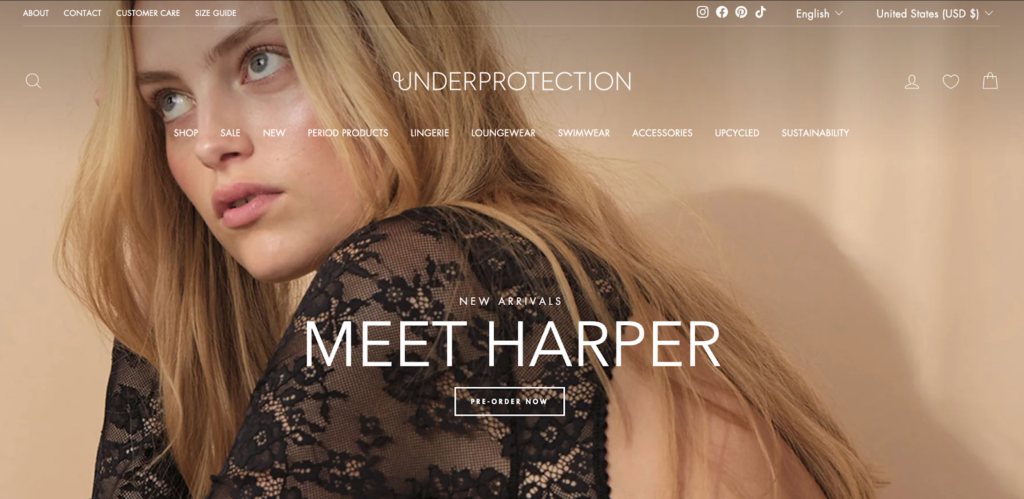
“We always strive to make the most sustainable choices even if it is not necessarily the most economically sensible choice, but for us, it is not only a business, it’s a lifestyle and a belief that the future must and can be greeners. It is our goal to always improve – in everything we do”
Stephan Rosenkilde, Co-Founder of Underprotection
🌎
How do they ensure their sustainability?
Underprotection ensures their sustainability by sourcing low-impact textile and packaging materials, prolonging their garments’ lifespan, and striving toward textile circularity. Firstly, they use a high proportion of eco-friendly fabrics, including TENCELTM Lyocell, organic cotton, recycled wool, and RWS-certified responsible sheep wool. All their synthetic fabrics come from recycled sources with the Global Recycle Standard certification, be it polyester, nylon, or elastane (spandex). On top of that, Underprotection also has fabrics made by utilizing by-product waste (banana leaves from the fruit industry and sour milk from the milk industry), helping to cut down waste and lower their environmental impacts. Regarding packaging materials, they opt for recycled or biodegradable materials. Secondly, the brand designs their products with quality and durability in mind to make them last, offers guaranteed repairs within the first two years, provides first-aid rewards for customers who fix up items themselves instead of replacing them, and equips consumers with detailed wash and care instructions for various types of fabrics. All these efforts aim to extend the lifespan of a garment and reduce its environmental cost. Thirdly, regarding their efforts toward textile circularity, they have a take-back program to give worn-out Underprotection pieces a second life, and an Upcycled collection that utilizes returned Underprotection products through their Take-back program, which covers leftover fabrics and discarded items. Last but not least, their main supplier uses solar-powered energy and harvests rainwater.
🌐
How do they ensure their ethics?
Underprotection ensures their ethics by holding a transparent and responsible supply chain. They bind their suppliers with a Code of Conduct, which covers all of the ILO’s Fundamental Principles and Rights at Work. Their suppliers have certifications that guarantee proper working conditions and a fair wage, including WRAP (Worldwide Responsible Accredited Production), Sedex, GOTS, and BSCI (Business Social Compliance Initiative). Underprotection also audits most of the final stage of production.
🤝
Are they part of any giving-back programs?
Underprotection partners with various organizations to give back to underprivileged communities and the Earth. For example, they plant a fixed 150 trees every month in their partnership with Treeapp. Another example is their partnership with the ReSea Project, an organization on a mission to end the ocean plastic crisis. Part of their sales go to support the cause.
🛍️
What is their product range?
- Best for: womenswear
- Product range: lingerie, loungewear, swimwear
- Price range: $$$
- Size range: XS–XL
The Ethical Silk Company: Silk Clothing and Bedding Made Ethically and Eco-Consciously


“Embracing this natural fabric (silk), our products combine a love for quality goods and sustainable practices as luxury and practicality are celebrated and embodied.”
The Ethical Silk Company
🌎
How do they ensure their sustainability?
The Ethical Silk Company ensures sustainability by minimizing waste, using low-impact dyes, and recycling process water. They avoid large inventory and associated waste by keeping the production runs short and only repeating the runs when demand dictates. Old stock is repurposed into smaller items, so each piece of silk is carefully utilized. Patterns are placed on fabrics carefully to keep wastage minimal during production. During the dyeing step of manufacturing, the brand focuses on lowering the environmental impact by eliminating high-impact AZO dyes. Additionally, all water used is treated with a water filtration system to remove the dye residue and is recycled for fabric washing. Their manufacturing partner also has a rainwater catchment system to use in fabric processing. When the season allows (meaning there is no monsoon), their silk can be block printed by hand and left to dry naturally outside, saving process energy and lowering carbon emissions. Lastly, The Ethical Silk Company sources responsible packaging for their silk products, including compostable, corn-based clear bags from Ecoland, recycled and recyclable mailers from Lil Packing, and tissue paper wrapping.
🌐
How do they ensure their ethics?
The Ethical Silk Company works with a Fair Trade tailoring unit to make their products, ensuring fair labor standards, including but not limited to clean and safe working conditions, payment of a living wage, no child labor, and no discrimination. Regarding animal welfare, The Ethical Silk Company exclusively sources mulberry silk extracted from a cocoon after the moth has left it, as opposed to the cruel practice in conventional silk manufacturing in which the cocoons are boiled to prevent the moths from breaking the silk filament as they emerge.
🤝
Are they part of any giving-back programs?
Since their inception, The Ethical Silk Company has committed to donate 10% of their profits to charitable causes. Currently, the charities of choice are Jeevan Jyothi AIDS Centre in Theni, India, which works to support those living with HIV and AIDS, and Focus Ireland, a charity preventing people from becoming, remaining, or returning to homelessness.
🛍️
What is their product range?
- Best for: kidswear, menswear, womenswear
- Product range: sleepwear, loungewear, tops, pants, slips, pajamas, robes
- Price range: $$$
- Size range: XS–XL
Boody: Fit-For-All Everyday Essentials Made With Eco-Friendly Materials


“Boody emphasises quality and simplicity. We bypass trends and fads as we believe they lead to overconsumption and waste.”
Boody
🌎
How do they ensure their sustainability?
Boody ensures sustainability by sourcing organic bamboo and organic cotton for their fabrics, reducing manufacturing waste, recycling all water used in production, and using recycled packaging. By sourcing plant materials from organic farms, Boody helps to keep out synthetic pesticides and fertilizers. Furthermore, their bamboo lyocell, LYOLYTE™, and bamboo viscose are manufactured in closed-loop systems where liquids and solvents are recycled, reused, or safely removed. Their cotton fibers are organically grown and certified by the Global Organic Textile Standard. Boody also has a zero-waste design, which enables knitting garments in tubes, leaving behind very little fabric wastage. Lastly, they encourage recycling of Boody’s ready-to-retire apparel by partnering with UPPAREL to launch The Goodness Loop. This platform enables consumers to buy a return shipping label, which starts the recycling process, and get a gift voucher to redeem on Boody’s new products.
🌐
How do they ensure their ethics?
Boody enforces fair labor practices by upholding suppliers to their Code of Conduct, which covers four of the ILO’s Fundamental Principles and Rights at Work. They also trace most of their supply chain. Lastly, the suppliers in their final production stage are certified by the Worldwide Responsible Accredited Production (WRAP).
🤝
Are they part of any giving-back programs?
As a 1% for the Planet member, Boody donates 1% of all their online sales to non-profits who help protect the environment. Additionally, they give 10% of all online beanie sales to the Chris O’Brien Lifehouse, a not-for-profit hospital and research institute dedicated to transforming cancer care. They also work with Thread Together to provide new clothing to less privileged Australians.
🛍️
What is their product range?
- Best for: kidswear, menswear, womenswear
- Product range: underwear, activewear, maternity wear, socks, stockings, tights, shorts, plus-size
- Price range: $$
- Size range: XXS–XXL
Tentree: A Lifestyle Clothing Brand That Plants Trees for Every Item Purchased

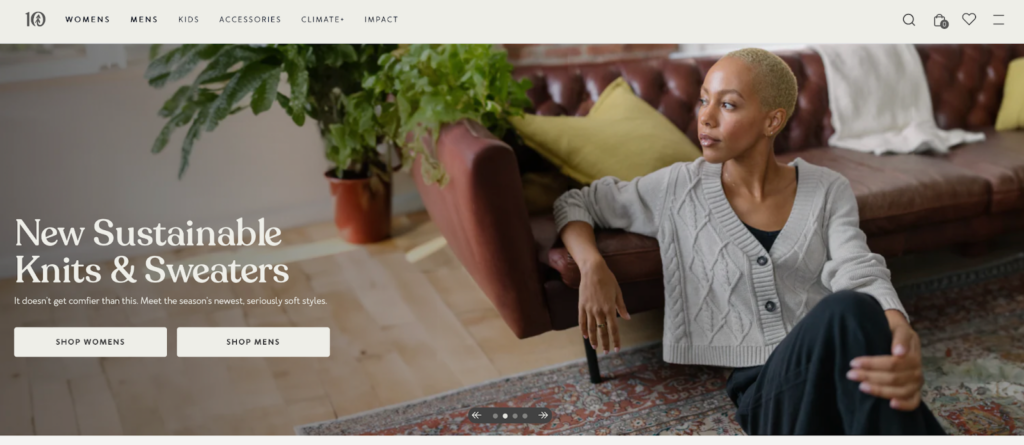
“ We believe the future of business is restorative.”
Tentree
🌎
How do they ensure their sustainability?
Tentree ensures sustainability by planting trees, promoting circularity, opting for low-impact fabrics, and attaining responsible packaging. Since their inception, they have planted more than 100,000,000 trees, which helps regenerate ecosystems, capture carbon, and provide forestry jobs in communities around the world. Together with textile recycler SuperCircle and resale guru Treet, Tentree has created an integrated solution to resell or recycle pre-loved Tentree clothing items, keeping them in circulation and out of landfills. Tentree also uses eco-friendly fabrics and blends, including organic cotton, hemp, recycled polyester, and TENCEL™. For example, the InMotion Tank top is made with recycled polyester (REPREVE®) and is ideal for hitting the gym. Regarding packaging, they replaced all single-use plastics with FSC-certified and 100% recycled paper. Finally, they have B Corporation and Climate Neutral certifications.
🌐
How do they ensure their ethics?
Tentree enforces fair labor practices by collaborating only with manufacturers and suppliers that guarantee a safe and respectful environment for their employees. They also regularly audit their partner facilities to ensure compliance with their Code of Conduct and international labor standards. Part of their supply chains is certified by organizations that protect workers, such as Fair Wear Foundation, Global Organic Textile Standard, Sedex Members Ethical Trade Audit, and Worldwide Responsible Accredited Production – WRAP. Additionally, Tentree commits to protecting forests through their paper, packaging, and fabric choices.
🤝
Are they part of any giving-back programs?
Giving back is a cornerstone of Tentree’s mission. Tentree plants 10 trees worldwide for every item purchased, contributing to reforestation and combating climate change. In 2022 alone, their customers helped plant over 22 million trees across nine countries, restoring over 2,000 hectares of terrestrial forests, over 1,000 hectares of coastal mangrove forests, and hundreds of hectares of marine land.
🛍️
What is their product range?
- Best for: kidswear, menswear, womenswear
- Product range: T-shirts, tank tops, shirts, sweaters, cardigans, dresses, pants, hoodies, dresses, shorts, skirts, joggers, jackets, coats, underwear
- Price range: $$
- Size range: XXS–XXL
Organic Basics: A Carbon Neutral Brand Creating Underwear, Activewear, and Everyday Essentials

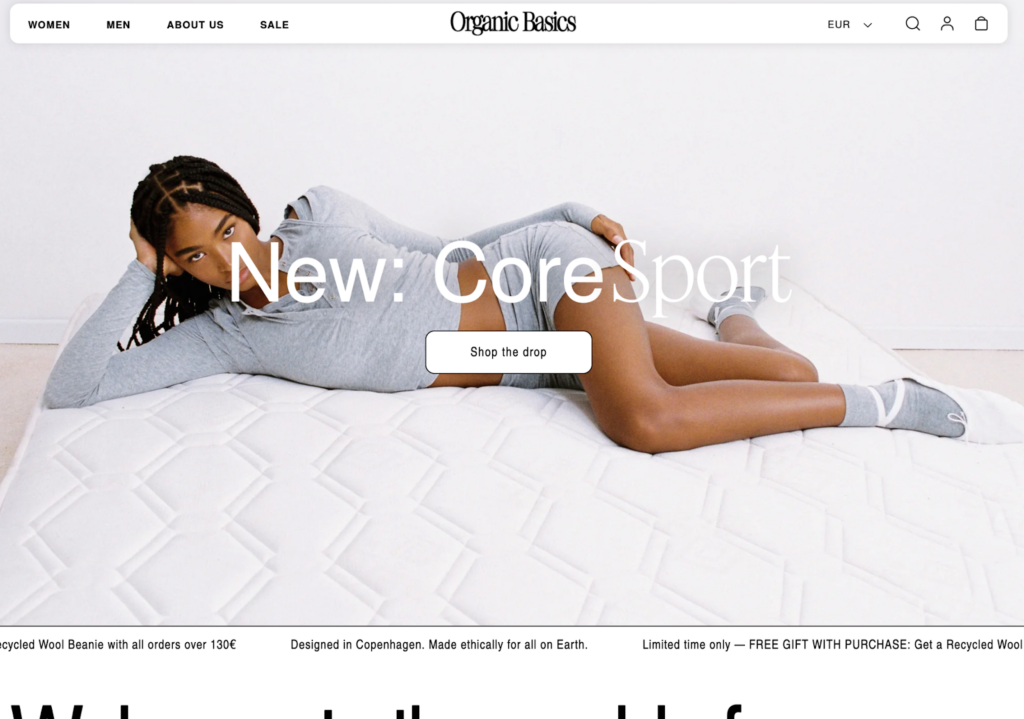
“We make our basics to be both Earth- and people-friendly — carefully choosing materials and fabrics that care for our environment, only partnering with factories that consider their impact too, and designing all the basics for all bodies.”
Organic Basics
🌎
How do they ensure their sustainability?
Organic Basics promotes sustainability by choosing fabrics based on their environmental footprint and lifetime durability. Their clothes are made of organic fabrics (cotton certified by the Global Organic Textile Standard), low-impact textiles (TENCEL™ Lyocell certified by the STANDARD 100 by OEKO-TEX®), or recycled materials (recycled wool, recycled cotton, and recycled nylon). They use a small percentage of elastane (spandex) in some garments to extend the products’ longevity, which ultimately extends the lifespan. For example, the Recycled Cotton Move Bralette is made with 70% organic cotton, 25% recycled cotton, and 5% elastane. Organic Basics is fully transparent about the impact of their products, enabling consumers to understand their share in using the clothes. They also partners with Made2Flow, which calculates their emissions, and One Carbon World, helping them reduce and offset all their emissions. Finally, they are also a B Corporation.
🌐
How do they ensure their ethics?
Organic Basics works only with trusted, certified factory partners, who ensure that their workplace is free of child labor and forced labor and that their workers enjoy a safe working space, earn a living wage, and benefit from employee perks like free lunches and childcare. They show full transparency of the location and practices in their factories. Organic Basics also audits or visits most of their suppliers.
🤝
Are they part of any giving-back programs?
Organic Basics donates 1% of the value of all orders to sustainable projects. Their partnership with Beam Impact enables consumers to choose where their 1% donation will go, at no extra cost to the consumers, to support local charities that help Nature Conservation, Ocean Conservation, Rewilding, or Sustainability & Gender Equity.
🛍️
What is their product range?
- Best for: womenswear, menswear
- Product range: underwear, loungewear, bottoms, T-shirts, tops, sweatshirts, hoodies, knitwear dresses, swimwear, socks, plus-size
- Price range: $$$
- Size range: XXS–XXL
Araks: US-Made Intimate Garments

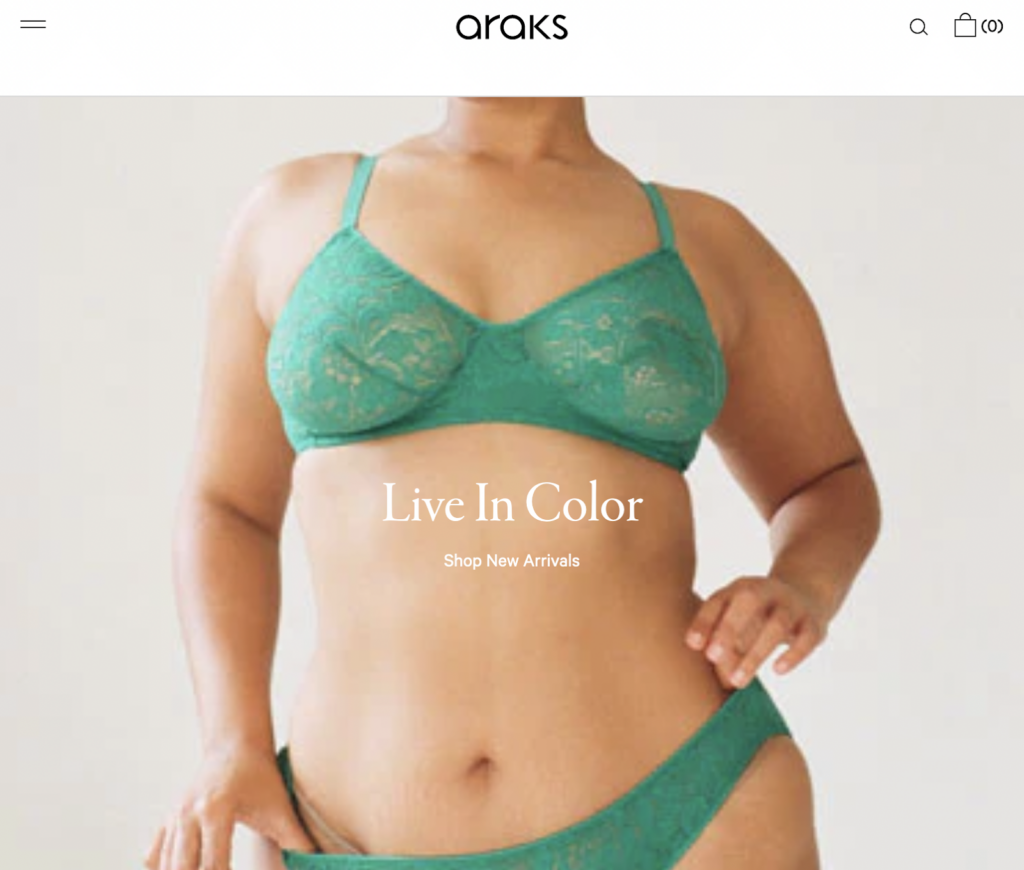
“Sustainability is a way of life for us and a journey of continuous improvement.”
Araks
🌎
How do they ensure their sustainability?
Araks’s sustainability incentives are guided by reducing, reusing, and recycling their products. They design their swimwear, loungewear, and lingerie around evergreen core fabrics, meaning that excess materials can be worked into future seasons instead of discarded. These include a medium proportion of low-impact materials, such as organic cotton with GOTS and OEKO-TEX® STANDARD 100 certifications, plant-dyed organic linen, ECONYL® (recycled nylon), and REFIBRA™ (closed-loop regenerated fibers using cotton waste). In particular, 50% of the fabrics used for their swim collection are recycled nylon (instead of virgin nylon). Additionally, their swimwear pieces are designed to mix and match across seasons, enabling consumers to buy fewer pieces while using each piece more often. Further down the life-cycle in the manufacturing stage, Araks saves scraps to be reused or donated to schools and other charitable organizations. They also reduce their manufacturing environmental impacts by opting for renewable energy and water recycling in their supply chain, as well as holding the final stage of manufacturing locally in the US. Araks’s incentive to reduce doesn’t stop at the point of sale. Instead, they invest in sharing the most low-impact ways to care for garments so that they leave as small of a footprint as possible, post-purchase.
🌐
How do they ensure their ethics?
Araks traces most of their supply chain, including all of the second and final stages of production. They share details of various mills that supply their fabrics, such as their location and sustainability certifications. Their manufacturing partners are also located in the US, a medium-risk country for labor abuse.
🤝
Are they part of any giving-back programs?
Araks is not known to be part of any giving-back programs.
🛍️
What is their product range?
- Best for: womenswear
- Product range: swimwear, loungewear, lingerie, plus-size
- Price range: $$$
- Size range: XS–XXL
HARA the Label: Garments Designed Collectively for You and Our Earth


“We stand for slow fashion, transparent supply chains and an ethical production line you can be proud to support.”
HARA the Label
🌎
How do they ensure their sustainability?
HARA the Label promotes sustainability by using mostly low-impact organic bamboo lyocell fabrics for garments. They source only bamboo grown without synthetic pesticides, insecticides, and fertilizers from suppliers with an OEKO-TEX® Standard 100 certification. Further down the life-cycle in the manufacturing stage, their bamboo lyocell fabrics are produced in a closed-loop system that filters and reuses all the water and solvent. Additionally, all their clothing items are colored with low-impact, non-toxic dyes. Specifically, they use natural dyes derived from plants like turmeric, indigo, and madder root, as well as GOTS-certified fiber-reactive dyes, which require relatively low water. Lastly, HARA the Label produces clothes locally in Australia to reduce transport carbon footprint.
🌐
How do they ensure their ethics?
HARA the Label traces most of their supply chain, including the final stage of production in Australia.
🤝
Are they part of any giving-back programs?
HARA the Label is not known to be part of any giving-back programs.
🛍️
What is their product range?
- Best for: womenswear
- Product range: underwear, loungewear, loungewear, plus-size
- Price range: $$$
- Size range: XS–5XL
Printfresh: Loungewear With a Focus on Beautiful Vibrant Prints


“Our pajamas are truly meant to spark joy – and what better way to do just that than knowing they were mindfully produced with sustainability best practices in mind. ”
Amy Voloshin, Co-Founder of Printfresh
🌎
How do they ensure their sustainability?
Printfresh ensures sustainability by prioritizing low-impact materials, minimizing waste, and reducing carbon emissions. Firstly, they source organic cotton for garments like pajamas and sleep sets. Printfresh also uses viscose that they source exclusively from forests following the principles of Sustainable Forestry Management. Regarding packaging, the brand uses 100% recycled ivory poly mailers made from 100% recycled content, with 50% coming from post-consumer waste. Secondly, they strive to minimize waste in textile production while recycling wastewater. On top of that, Printfresh pattern masters employ effective pattern layouts and low-waste cutting techniques to keep leftover fabric scraps minimal. All usable scraps are stored for upcycled projects. Furthermore, their sewing factory and printing facility recycle wastewater onsite for reuse. Lastly, Printfresh reduces carbon emissions by using solar energy in their supply chain and transporting inventory by boat.
🌐
How do they ensure their ethics?
Printfresh partly traces their supplier chain, including the final and some of the second production stages. Their manufacturing partner is third-party audited by SEDEX to ensure their practices are ethically and environmentally aligned with Printfresh.
Is Brand part of any giving-back programs?
In 2021, the brand joined Pledge 1%, a global movement creating a new normal for companies of all sizes and stages to have a positive social impact through their business. They have given back to various organizations, including the International Rescue Committee, GiveIndia, Loveland Foundation, Save the Golden Lion Tamarin charity, and the MADE Institute in Philadelphia.
🛍️
What is their product range?
- Best for: womenswear
- Product range: loungewear, dresses, blouses, T-shirts, sweatsuits, ponchos
- Price range: $$
- Size range: XS–6XL
Pact: Stylish, Comfortable, Essential Clothing Made Ethically and Sustainably


“We believe the planet, and the people on it, should always come first in fashion.”
Pact
🌎
How do they ensure their sustainability?
Pact ensures sustainability by using low-impact textile and packaging materials, offsetting the carbon impact of all their products, and facilitating the donation of used clothes to reduce waste. They use a high proportion of eco-friendly fabrics, including GOTS-certified organic cotton. Additionally, their clothes are delivered in VelaTM paper bags. These bags are made with carbon-neutral, FSC-certified, recyclable paper. Pact also partners up with SimpliZero. This partnership enables measuring the impact of every product Pact makes and offsetting it through reforestation, renewable energy, and community projects sequestering carbon from the atmosphere. Their Give Back Box incentive enables their customers to reuse the boxes their pact orders came in and donate their used clothes to local charities with the postal fee paid for by Pact.
🌐
How do they ensure their ethics?
Pact uses Fair Trade CertifiedTM factories, providing safe working conditions, community support, and additional development funds to workers in their supply chain. They trace most of their supply chain, including all of the final stages of production.
🤝
Are they part of any giving-back programs?
Pact is not known to be part of any giving-back programs.
🛍️
What is their product range?
- Best for: womenswear, menswear
- Product range: dresses, hoodies, sweatshirts, activewear, sleepwear, maternity wear, T-shirts, underwear, jumpsuits, playsuits, plus-size
- Price range: $$$
Noctu: Sleep and Loungewear Made Exclusively With Organic Cotton
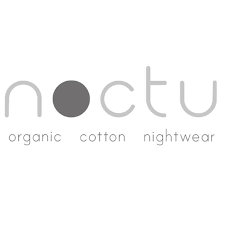

“We strive to minimise our ecological footprint, promote ethical practices, and inspire positive change within the fashion industry.”
Noctu
🌎
How do they ensure their sustainability?
Noctu promotes sustainability by sourcing low-impact materials and reducing their carbon emissions. Firstly, they use exclusively GOTS-certified organic cotton to make their sleep and loungewear. Their garments are also certified by OEKO-TEX®, meaning that every product component, from the fabric to the thread and accessories, has been rigorously tested against a list of up to 350 toxic chemicals. Regarding packaging, Noctu also opts for recyclable and biodegradable materials. They use tissue paper and paper mail bags and don’t use plastic in their packaging. Secondly, they strive to minimize their carbon footprint by implementing energy-efficient practices, carbon offsetting our mail order deliveries, and manufacturing locally in England to reduce transportation emissions.
🌐
How do they ensure their ethics?
Noctu traces most of their supply chain. The last stage of production happens in England, where the brand prioritizes good wages, safe working conditions, and workers’ rights.
🤝
Are they part of any giving-back programs?
Noctu contributes to the World Land Trust and donates money from each sale to purchase 10 square meters (~108 square feet) of endangered wildlife.
🛍️
What is their product range?
- Best for: womenswear, menswear, kidswear
- Product range: bottoms, tops, nighties, jumpsuits, accessories
- Price range: $$
- Size range: XS–XXL
Proclaim: Eco-Friendly Skin Tone Lingerie Made in the US

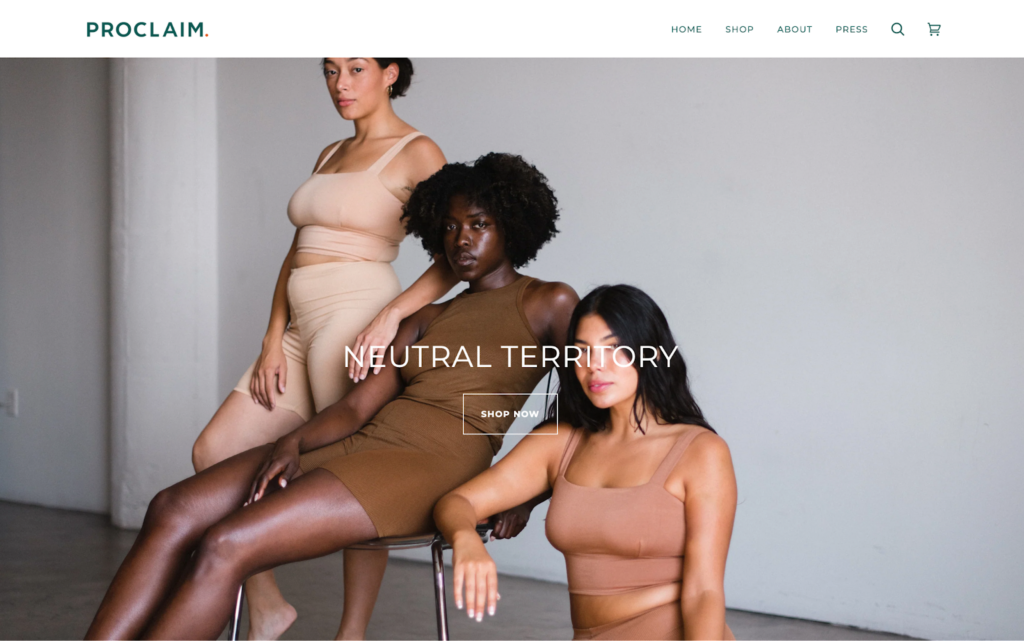
“We are founded on the principles that fashion should represent all women and can be made in a way that does good for people and the planet. Proclaim is expanding the definition of nude, one ethically made bra at a time.”
Proclaim
🌎
How do they ensure their sustainability?
Proclaim ensures sustainability by sourcing a high percentage of low-impact fabrics, reducing waste, and lowering carbon emissions. Firstly, they use four of the most sustainable fabrics: organic cotton, hemp, https://www.wearproclaim.com/TENCEL™, Lyocell, and recycled polyester (REPREVE®). Secondly, they reduce waste by sourcing recycled materials (REPREVE® and Cupro), designing strategically to avoid fabric scraps during the cutting process, and repurposing scraps into new building materials. Last but not least, their supply chain is localized to a 30-mile radius to reduce transportation carbon emissions.
🌐
How do they ensure their ethics?
Proclaim makes their clothes in the US,a medium-risk country for labor abuse. They trace most of their supply chain, including all of the final and second stages of production. Their manufacturing partner is a family-run, BIPOC-owned apparel factory in LA that pays well above minimum wage.
🤝
Are they part of any giving-back programs?
During the COVID-19 pandemic, Proclaim created a “buy one, donate one” model of mask and donated masks, meals, and hygiene kits to the Downtown Women’s Center in LA.
🛍️
What is their product range?
- Best for: womenswear
- Product range: bras, panties, loungewear,
- Price range: $$$
- Size range: S–3XL
aiayu: Quality Garments Made Responsibly
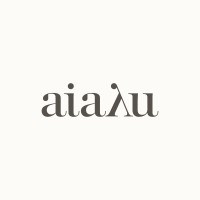

“aiayu is rooted in nature’s own materials—our inspiration stems from finding natural, sustainable materials and colors. We refine the things that nature has created through our gentle natural palette, revealing materials and yarns primarily in their natural color, made without the use of chemicals dyes”
Maria Heilmann, Founder of aiayu
🌎
How do they ensure their sustainability?
aiayu ensures sustainability by sourcing low-impact natural materials from responsible production. They use a medium proportion of recycled cotton and organic cotton certified by the Global Organic Textile Standard. They also source animal-derived fabrics, yet they partner with suppliers that ensure the health of the land and the animals. Specifically, aiayu sources Sartuul sheep and yak wool from nomadic herders in the Green Gold project, who are working to protect and restore Mongolia’s grasslands. Additionally, they reduce the impact of using wool by opting for the hair of “gentle grazers” like llamas or blending wool with lower-impact materials (such as cashmere and linen). On top of that, aiayu’s Eri silk is made by silkworms fed with castor leaves instead of mulberry leaves. Unlike mulberry cultivation in conventional silk production, castor cultivation in the sourcing area is gentler for the land because these trees require no irrigation, fertilizer, or pesticides. Further down the life-cycle in the manufacturing stage, aiayu reduces their impact by keeping many knits undyed to lower the chemical usage, using renewable energy in their supply chain to cut down their climate impact, and employing a closed-loop system to reduce water use. Lastly, they help prolong their products’ lifespan with complimentary repair service, reducing the life-cycle’s environmental impact.
🌐
How do they ensure their ethics?
aiayu traces most of their supply chain. To ensure safe and ethical working environments, they opt to work with production partners with leading social responsibility certifications, including SA8000, BSCI, and WRAP. Regarding animal welfare, they use eri silk, sometimes called “peace silk,” as the silky cocoons are only harvested after the moths have naturally emerged from them, in contrast to the cruel practice in conventional silk production.
🤝
Are they part of any giving-back programs?
aiayu is not known to be part of any giving-back programs.
🛍️
What is their product range?
- Best for: womenswear
- Product range: outerwear, knitwear, shirts, T-shirts, dresses, blouses, pants, shorts, loungewear
- Price range: $$$
- Size range: XS–XL
YesAnd: Clothing Brand That Plants Mangrove Forests


“No one should have to compromise on their values. It’s about yes, and. Looking and feeling fabulous shouldn’t come at the expense of living in harmony with the environment.”
Marci Zaroff, Founder of YesAnd
🌎
How do they ensure their sustainability?
YesAnd ensures sustainability by sourcing low-impact fabrics and dyestuff. They use a high percentage of eco-friendly plant-based materials, including organic cotton and lyocell (Lenzing’s TENCEL™). In addition, YesAnd opts for low-impact, non-toxic dyes for their fabrics, complying with the Global Organic Textile Standard (GOTS). YesAnd also strives for circularity by designing for longevity and quality and facilitating lifespan extension by partnering with fashion rental site Wardrobe to keep YesAnd in the system longer.
🌐
How do they ensure their ethics?
YesAnd traces and audits most of their supply chain. They are committed to fair wages, empowering female farmers, sustaining their local communities, and eliminating child labor. They are also working to enable the traceability of their products from seeds to skin, using blockchain technology powered by Storybird. Consumers can scan the QR code found on the inside tag of a garment to trace back to the piece’s origin.
🤝
Are they part of any giving-back programs?
YesAnd plants a mangrove tree for every order, offsetting some of their carbon impact with the most efficient variety of trees for climate change mitigation.
🛍️
What is their product range?
- Best for: womenswear, menswear
- Product range: tops, bottoms, dresses, jackets, sweatshirts, hoodies, T-shirts, sleepwear, loungewear, jumpsuits, accessories
- Price range: $$
- Size range: XS–XL
Why Is It Important to Buy Products Made of More Sustainable Fabrics
It is important to buy products made from more sustainable fabrics because a sustainable textile industry has a lower carbon footprint, helps save natural resources, and is better for forests, animals, and humans alike.
Buying Sustainable Fabrics Reduces Your Carbon Footprint
The production of clothing and footwear is estimated to contribute 10% of global greenhouse gas emissions—more than all international flights and shipping combined. If the fashion industry were a country, it would be the fourth largest emitter of carbon dioxide.
One way to reduce the carbon footprint of the clothes you buy is to opt for sustainable fabrics. Sustainable fabrics, which are often made with natural or recycled fibers, have relatively low carbon footprints compared to petroleum-based fabrics. For example, organic cotton made in the US has a carbon footprint of 2.35 kg CO2 (per ton of spun fiber)—a quarter of polyester’s carbon footprint.
Buying Sustainable Fabrics Reduces Demand for Natural Resources and Waste Management
The textile industry uses water and land to grow cotton and other fibers. It is estimated that 79 billion cubic meters of water were used for the sector worldwide in 2015. For example, producing a single cotton T-shirt requires as much water as one person drinks for 2.5 years (2,700 liters of fresh water).
Worse yet, the textile economy is vastly more linear than circular: the largest amount of resources used in clothes ended up in landfills (instead of being recycled to remake clothes). According to a report by the Ellen MacArthur Foundation,
- Less than 3% of materials used in the textile economy in 2015 came from recycled sources.
- In other words, more than 97% of resources used in making clothes are newly extracted.
When clothing items are disposed of within a short period of time—under a year in the case of half of the fast fashion clothes—the natural systems that provide raw materials for fabrics don’t have enough time to recover and regenerate, which could lead to ecological breakdown.
Sustainable fabrics are made with less water and emissions while lasting longer:
- Because they are durable, you don’t need to buy new clothes too often.
- Thus, you help reduce the pressure to extract more resources for making new items.
Similarly, making and consuming sustainable fabrics made with recycled materials reduces the demand for virgin materials while helping tackle waste management.
Buying Sustainable Fabrics Encourages Sustainable Management of Forests
Sustainable plant-based fabrics are made with raw materials from forests and plantations that are sustainably managed, such as complying with FSC standards.
When you buy sustainable plant-based fabrics, you discourage unsustainable forestry practices like illegal logging. You can help reduce deforestation, biodiversity loss, and the effects of climate change.
Buying Sustainable Fabrics Encourages Fairer Treatment of Animals
The fashion industry is rife with animal mistreatment when it comes to making animal-based fabrics like wool or silk. Every year, billions of animals suffer and die for clothing and accessories.
Buying sustainable vegan alternatives can help to reduce the pressure on raising more and more animals to meet the demand for animal-based fabrics while sacrificing their well-being and lives.
Suppose you have to buy fabrics made with, for example, wool or silk; make sure you only choose brands committed to cruelty-free products. In that case, you help advocate better treatments for animals raised within the textile industry.
Using Sustainable Fabrics Encourages Fairer Treatment of Textile Workers
Recent statistics from UNICEF estimated as many as 170 million child laborers worldwide, many of whom were engaged in some form of work in the textile industry. They don’t get paid minimum wages and often work long hours.
When you buy sustainable fabrics from brands transparent about the working conditions at their factories, you discourage the use of child labor and help promote better working conditions for textile workers.
How Can You Generally Buy More Sustainable Fabrics
The key to sustainably buying fabrics is to check on relevant environmental and original certifications.
For natural fabrics:
- Global Organic Textile Standard (GOTS): A globally recognized certification system that ensures a certain threshold of organic content has been met. It covers manufacturing, packaging, labeling, transportation, and distribution (but not what happens in the fields where crops are grown).
- USDA Certified Biobased Product: The USDA BioPreferred® Certification is a voluntary certification offered by the United States Department of Agriculture. The certification identifies products made from plants or other renewable materials.
- Ecolabel: Ecolabel is the official European Union voluntary label recognized worldwide for certified products with a guaranteed, independently verified low environmental impact. The label requires high environmental standards throughout the entire life-cycle: from raw material extraction through production and distribution to disposal. It also encourages companies to develop innovative, durable, easy-to-repair, and recyclable products.
For plant-based semi-natural/semi-synthetic fabrics:
- Forest Stewardship Council: An FSC certification ensures that the wood (or wood-like material) comes from responsibly managed forests that provide environmental, social, and economic benefits.
There are two types of FSC Certification:- FSC Forest Management Certification, with a focus on the origin of the wood—the forest.
- FSC Chain of Custody Certification, which focuses on the path from the forest to the customer’s home.
- Program for Endorsement of Forest Certification: PEFC’s approaches to sustainable forest management are in line with protecting the forests globally and locally and making the certificate work for everyone. Getting a PEFC certification is strict enough to ensure the sustainable management of a forest is socially just, ecologically sound, and economically viable but attainable not only by big but small forest owners.
For recycled fabrics:
- Recycled Claim Standard (RCS): The Textile Exchange RCS was originally developed as an international, voluntary standard that sets requirements for third-party certification of Recycled input and chain of custody.
- The Global Recycled Standard (GRS): The Global Recycled Standard (GRS) is an international, voluntary, full product standard that sets requirements for third-party certification of Recycled Content, chain of custody, social and environmental practices, and chemical restrictions. It can be used for any product with more than 20% recycled material.
For all types of fabrics:
- STeP by OEKO-TEX®: STeP by OEKO-TEX® is an independent certification system for brands, retailers, and manufacturers from the textile and leather industry. It communicates organizational environmental measures, including reducing carbon footprint and water usage.
- OEKO-TEX® Standard 100: OEKO-TEX® labels aim to ensure that products pose no risk to human health (i.e. containing banned chemicals).
Some certifications that are signaling brands’ efforts toward lowered environmental impacts and a circular economy are:
- B Corp Certification: The label B Corp is a certification reserved for for-profit companies. Certified holders are assessed on their social and environmental impacts.
- Cradle2Cradle certification: Cradle2Cradle provides a standardized approach to material circularity. It assesses whether products have been suitably designed and made with the circular economy in mind covering five critical categories: material health, material reuse, renewable energy and carbon management, water stewardship, and social fairness.
Final Thoughts
The sustainability of loungewear depends mostly on the fabrics used. Generally, plant-based fibers cultivated organically are the most sustainable option for loungewear.
By purchasing loungewear from brands that commit to sustainability, you support their mission to create a fairer and less harmful textile industry for all lives on Earth.
Here is the list (again) of the most sustainable loungewear brands:
- hernest project
- Subset
- Underprotection
- The Ethical Silk Company
- Boody
- Tentree
- Organic Basics
- Araks
- Hara the Label
- Printfresh
- Pact
- Noctu
- Proclaim
- aiayu
- YesAnd
To make your use of these clothing items even more sustainable, follow these steps:
- Buy recycled or upcycled loungewear made with low-impact materials.
- Keep your loungewear for as long as possible.
- At the end-of-life of your loungewear, upcycle the materials to extend their usage and arrange for them to be recycled or properly disposed of.
Stay impactful,

Sources
- Impactful Ninja: How Sustainable Are Synthetic Fabrics? A Life-Cycle Analysis
- Impactful Ninja: How Sustainable Are Natural Fabrics? A Life-Cycle Analysis
- Science Direct: Life-cycle assessment (LCA)
- hernest project: Home
- Subset: Home
- Underprotection: Home
- The Ethical Silk Company: Home
- Boody: Home
- Tentree: Home
- Organic Basic: Home
- Araks: Home
- HARA the Label: Home
- Printfresh: Home
- Pact: Home
- Noctu: Home
- Proclaim: Home
- aiayu: Home
- YesAnd: Home
- Good On You: Brand Directory | hernest project
- hernest project: Design Principles
- hernest project: how we’re going carbon neutral
- OEKO-TEX: STANDARD 100 by OEKO-TEX
- Bluesign: Home
- Impactful Ninja: How Sustainable Are TENCEL Fabrics? A Life-Cycle Analysis
- Impactful Ninja: How Sustainable Are Recycled Cotton Fabrics? A Life-Cycle Analysis
- Impactful Ninja: How Sustainable Are Organic Cotton Fabrics? A Life-Cycle Analysis
- hernest project: Sustainable Fibers
- Impactful Ninja: How Sustainable Are Recycled Fabrics? A Life-Cycle Analysis
- Impactful Ninja: How Sustainable Are Lyocell Fabrics? A Life-Cycle Analysis
- Impactful Ninja: How Sustainable Are Linen Fabrics? A Life-Cycle Analysis
- hernest project: Our Packaging
- Treet: RE-Nest
- hernest project: Code of Conduct
- International Labour Organization: Fundamental Principles and Rights at Work
- hernest project: Our Partners
- Subset: Becoming Carbon Neutral
- Subset: Women’s Loungewear
- Good On You: Brand Directory | Subset
- Subset: SUBSET x Supercircle | Recycle your rejects
- Global Organic Textile Standard: Home
- Impactful Ninja: How Sustainable Are Organic Cotton Fabrics? A Life-Cycle Analysis
- Impactful Ninja: How Sustainable Are TENCEL Fabrics? A Life-Cycle Analysis
- Impactful Ninja: How Sustainable Are Recycled Polyester Fabrics? A Life-Cycle Analysis
- Impactful Ninja: How Sustainable Are Recycled Nylon Fabrics? A Life-Cycle Analysis
- Subset: Tank Bralette
- Subset: Our Materials
- Subset: 2022 Impact Report
- Subset: Organic Cotton Supply Chain
- Fairtrade: Fairtrade Standard for Small-Scale Producer Organisations
- I Support the Girls: Home
- Cultivate Initiatives: Home
- B Corporation: Underprotection
- Underprotection: Loungewear
- Impactful Ninja: How Sustainable Are Natural Fabrics? A Life-Cycle Analysis
- Good On You: Brand Directory | Underprotection
- Impactful Ninja: How Sustainable Are Lyocell Fabrics? A Life-Cycle Analysis
- Impactful Ninja: How Sustainable Are Recycled Wool Fabrics? A Life-Cycle Analysis
- Textile Exchange: Responsible Wool Standard
- Impactful Ninja: How Sustainable Are Sheep Wool Fabrics? A Life-Cycle Analysis
- Impactful Ninja: How Sustainable Are Synthetic Fabrics? A Life-Cycle Analysis
- Underprotection: Materials
- Textile Exchange: Global Recycle Standard
- Impactful Ninja: How Sustainable Are Polyester Fabrics? A Life-Cycle Analysis
- Impactful Ninja: How Sustainable Are Nylon Fabrics? A Life-Cycle Analysis
- Impactful Ninja: How Sustainable Are Spandex Fabrics? A Life-Cycle Analysis
- Impactful Ninja: How Sustainable Are Elastane Fabrics? A Life-Cycle Analysis
- Underprotection: Packaging
- Underprotection: Repair and Rewards
- Underprotection: Wash & Care
- Underprotection: Take-back program
- Underprotection: Upcycled
- Underprotection: I Tråd Med Verden
- Underprotection: Sustainable Report 2020
- Underprotection: Production
- Underprotection: Code of Conduct
- International Labour Organization: Fundamental Principles and Rights at Work
- Worldwide Responsible Accredited Production (WRAP): Home
- Sedex: Home
- Amfori: BSCI
- Underprotection: Green Friends
- Underprotection: TREEAPP
- Underprotection: ReSea
- The Ethical Silk Company: Silk Loungewear
- Good On You: Brand Directory | The Ethical Silk Company
- The Ethical Silk Company: OUR STORY
- Impactful Ninja: How Sustainable Are Silk Fabrics? A Life-Cycle Analysis
- The Ethical Silk Company: Shipping & Returns
- Lil Packing: Home
- Mehra Shaw: Fair Trade Standards
- Focus Ireland: Home
- B Corporation: Boody
- Boody: Womens’ loungewear and bralettes
- Impactful Ninja: How Sustainable Are Bamboo Fabrics? A Life-Cycle Analysis
- Boody: About Boody
- Good On You: Brand Directory | Boody
- Impactful Ninja: How Sustainable Are Bamboo Lyocell Fabrics? A Life-Cycle Analysis
- Boody: LYOLYTE™ Lyocell Underwear
- Impactful Ninja: How Sustainable Are Bamboo Viscose Fabrics? A Life-Cycle Analysis
- Boody: Our Process
- Impactful Ninja: How Sustainable Are Cotton Fabrics? A Life-Cycle Analysis
- Boody: The Goodness Loop
- Boody: Code of Conduct
- International Labour Organization: Fundamental Principles and Rights at Work
- Worldwide Responsible Accredited Production (WRAP): Home
- One Percent For The Planet: Home
- Boody: Soft Jersey Beanie
- Chris O’Brien Lifehouse: Home
- Thread Together: Home
- Tentree: Women’s Sustainable Loungewear
- Tentree: Tree Planting FAQ
- Tentree: Circularity By tentree
- Tentree: Our Materials
- Tentree: Thinking Outside the Box
- Tentree: WE’RE TENTRE | We Believe Big Change Starts Small.
- SuperCircle: Home
- Treet: Home
- Tentree: SuperCircle
- Impactful Ninja: How Sustainable Are Recycled Polyester Fabrics? A Life-Cycle Analysis
- Impactful Ninja: How Sustainable Are TENCEL Fabrics? A Life-Cycle Analysis
- Tentree: InMotion Tank | Recycled Materials
- REPREVE: Home
- Tentree: Eco-friendly socks
- Tentree: Responsible Packaging
- B Corporation: Tentree
- CLIMATE NEUTRAL: Tentree
- Tentree: Ethical Manufacturing
- Good On You: Brand Directory | Tentree
- Fair Wear Foundation: Home
- Sedex Members Ethical Trade Audit: Home
- Worldwide Responsible Accredited Production – WRAP: Home
- Shopify: Ten Tree International Inc. (tentree) | Commitment to Protect Forests Through Our Paper, Packaging and Fabrics Choices
- Tentree: THE ENVIRONMENTOR | Here’s Where We Plant Your Trees
- Tentree: 04 nature | TENTREE SUSTAINABILITY
- Organic Basics: Loungewear
- B Corporation: Organic Basics
- Organic Basics: Factories
- Good On You: Brand Directory | Organic Basics
- Organic Basics: Our Impact
- Beam Impact: Home
- Impactful Ninja: How Sustainable Are Silk Fabrics? A Life-Cycle Analysis
- Araks: Sustainability
- Good On You: Brand Directory | Araks
- Impactful Ninja: How Sustainable Are Organic Linen Fabrics? A Life-Cycle Analysis
- ECONYL: Home
- Tencel: REFIBRA™
- Araks: Materials
- Araks: Manufacturing
- Araks: Garment care
- HARA The Label: Loungewear
- HARA The Label: Bamboo Fabric
- OEKO-TEX: OEKO-TEX® Standard 100
- Good On You: Brand Directory | HARA the Label
- HARA the Label: Natural dyes
- Printfresh: Pajamas
- Printfresh: Satin Loungewear
- Printfresh: Sustainability
- Impactful Ninja: How Sustainable Are Organic Cotton Fabrics? A Life-Cycle Analysis
- Printfresh: Bagheera
- Good On You: Brand Directory | Printfresh
- Pledge 1%: Home
- International Rescue Committee: Home
- GiveIndia: Home
- Loveland Foundation: Home
- Save the Golden Lion Tamarin: Home
- MADE Institute: Home
- Pact: Loungewear
- Good On You: Brand Directory | Pact
- VelaTM paper bags: Home
- Pact: Responsible Packaging
- SimpliZero: Home
- Pact: Sustainability, Certified
- Pact: Give Back Box
- Global Organic Textile Standard (GOTS): Home
- Impactful Ninja: How Sustainable Are Organic Cotton Fabrics? A Life-Cycle Analysis
- Noctu: Sustainability
- OEKO-TEX: Home
- Good On You: Brand Directory | Noctu
- World Land Trust : Home
- Proclaim: Loungewear
- Good On You: Brand Directory | Proclaim
- Impactful Ninja: 20 Most Sustainable Fabrics: The Full Life-Cycle Analysis
- REPREVE: Home
- Impactful Ninja: How Sustainable Are Cupro Fabrics? A Life-Cycle Analysis
- Proclaim: WHO WE ARE
- Ethical Style Journal: Brand Spotlight: Proclaim
- Aiayu: Loungewear
- aiayu: Materials
- Impactful Ninja: How Sustainable Are Recycled Cotton Fabrics? A Life-Cycle Analysis
- Impactful Ninja: How Sustainable Are Organic Cotton Fabrics? A Life-Cycle Analysis
- Global Organic Textile Standard (GOTS): Home
- Impactful Ninja: How Sustainable Are Wool Fabrics? A Life-Cycle Analysis
- Impactful Ninja: How Sustainable Are Cashmere Fabrics? A Life-Cycle Analysis
- Impactful Ninja: How Sustainable Are Linen Fabrics? A Life-Cycle Analysis
- Impactful Ninja: How Sustainable Are Silk Fabrics? A Life-Cycle Analysis
- aiayu: Responsibility
- Good On You: Brand Directory | aiayu
- aiayu: Repair service
- SA International: SA8000
- Amfori: BSCI
- YesAnd: Loungewear
- Good On You: Brand Directory | YesAnd
- Impactful Ninja: How Sustainable Are Lyocell Fabrics? A Life-Cycle Analysis
- YesAnd: What is TENCEL™ anyway?
- YesAnd: Sustainability
- Yes And: Circularity: How to “Close the Loop” on Fashion
- Yes And: Connecting the Dots with Blockchain
- Storybird: Home
- European Parliament: The impact of textile production and waste on the environment (infographic)
- Science Direct: The challenge of “Depeche Mode” in the fashion industry – Does the industry have the capacity to become sustainable through circular economic principles, a scoping review
- Science Direct: Carbon Footprint of Textile and Clothing Products
- European Parliament: Environmental impact of the textile and clothing industry
- European Parliament: What if fashion were good for the planet?
- Ellen MacArthur Foundation: A New Textiles Economy: Redesigning fashion’s future
- McKinsey: Style that’s sustainable: A new fast-fashion formula
- Forest Stewardship Council: Home
- Our World in Data: Deforestation and Forest Loss
- Our World in Data: Renewable Energy
- Peta: Animals Used For Clothing
- The Guardian: Child labour in the fashion supply chain
- Impactful Ninja: How Sustainable Are Natural Fabrics? A Life-Cycle Analysis
- Global Organic Textile Standard (GOTS): Home
- BioPreferred: WHAT IS THE BIOPREFERRED PROGRAM?
- European Commission: Environment | EU Ecolabel
- Impactful Ninja: How Sustainable Are Semi-Natural/Semi-Synthetic Fabrics? A Life-Cycle Analysis
- Forest Stewardship Council
- FSC Forest Management Certification
- FSC Chain of Custody Certification
- Textile Exchange: The RCS and GRS are designed to boost the use of recycled materials
- Program for Endorsement of Forest Certification
- Impactful Ninja: How Sustainable Are Recycled Fabrics? A Life-Cycle Analysis
- Textile Exchange: Recycled Claim Standard
- Textile Exchange: Global Recycled Standard
- OEKO-TEX: Certification according to STeP by OEKO-TEX®
- OEKO-TEX: OEKO-TEX® Standard 100
- B Corp Certification: Home
- C2CCertified: Home





